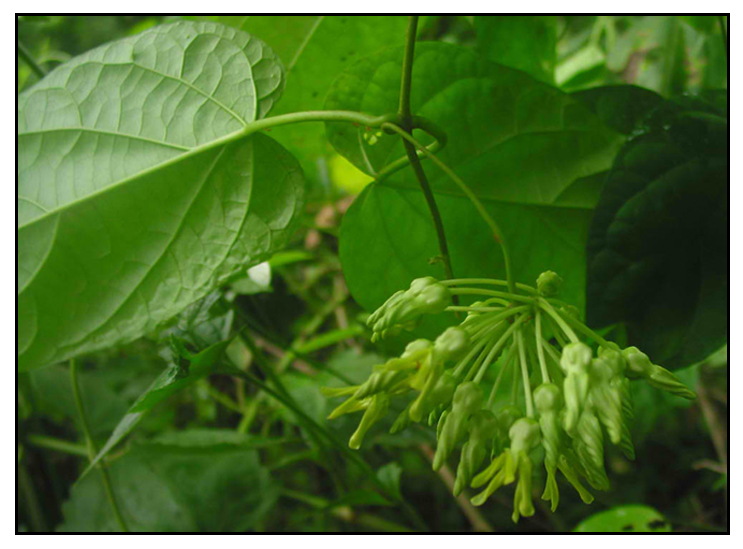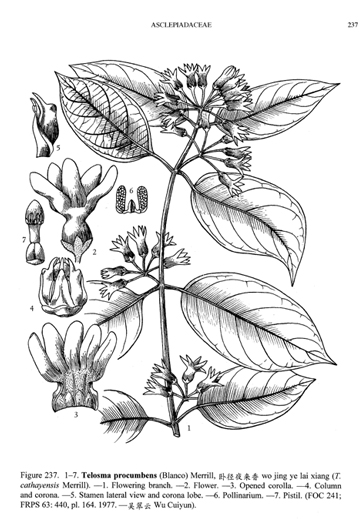 Botany Botany
Latok is a woody vine with slender, smooth or slightly hairy branchlets. Leaves are thin, ovate to oblong-ovate, 8 to 13 centimeters long, 3 to 8 centimeters wide, pointed at the tip and slightly heart-shaped at the base. Cymes are axillary and umbelliform. Flowers are numerous, greenish-yellow, odorless, about 1.5 centimeters long, and hairy at the throat. Fruit is lanceolate, about 15 centimeters long. Seeds are flattened and crowned with silky hairs.
Distribution
- In thickets and secondary forests at low altitudes in Ilocos Norte to Sorsogon Provinces in Luzon; and in Mindoro, Cuyo, Biliran, Leyte, Negros, Mindanao and Basilan.
- Also occurs in China and Vietnam.
 Constituents Constituents
- Phytochemical studies have yielded phenol, flavonoid, coumarin, tannin, terpenoid, steroids, and cardiac glycoside. (5)
-
Study yielded an intensely sweet polyoxypregnance glycoside, telosmoside A, together with 17 other new glycosides. (See study below) (1)
Constituents
- Considered anti-tussive, expectorant, hypoglycemic.
- Studies have suggested antioxidant, hypoglycemic, radical scavenging, sweetening properties..
Parts used
Leaves
Uses
Edibility
- Flowers and immature fruits eaten cooked.
-
Pericarp is cooked and eaten as vegetable, with the consistency and taste of string beans.
- In Albay, fresh leaves and stems have been reported to be poisonous to pigs.
- In Ilocos Norte, immature fruit used for making dinengdeng.
- Clustered inflorescence eaten as vegetable, sautéed and eaten with rice.
- In everyday vegetable in Thailand, steamed or boiled and served with spicy Nam Pric, friend with eggs as omelet, sautéed with meat or added to hot and sour soup. (2)
Folkloric
- Decoction or infusion of leaves used for cleansing wounds, scabies and ulcers.
- Leaves, as cataplasm, applied to the forehead for headaches.
- In Vietnamese folk medicine, whole plant is used as a substitute for licorice, due to its sweet taste. Also used as expectorant and antitussive. (1)
Studies
• Pregnane Glycosides / Intensely Sweet: An intensely sweet polyoxypregnane glycoside, telosmoside A15, was isolated from Asian Telosma procumbens. The sweetness has an intensity 1000 times greater than that of sucrose. The plant also yielded 17 other new glycosides, telosmosides A1-A14, and A16-A18. Some of these glycosides are sweet, while others are tasteless and bitter. (1)
• Anti-Diabetic / Leaves: Study evaluated an ethanolic leaf extract of Telosma procumbens for hypoglycemic activity in alloxan-induced diabetic mice. Results showed a dose-dependent blood glucose reducing effect. (3)
• Antimicrobial / Leaves and Flowers: Study evaluated the antimicrobial property of Telosma procumbens leaf and flower extracts against Staphylococcus aureus and Escherichia coli. Results showed antibacterial activity against S. aureus and E. coli with zones of inhibition of 20.67 and 23.67 mm for leaf extracts, respectively, and 16.67 mm and 20.67 mm for flower extracts, respectively. (5)
• Antioxidant / Radical Scavenging Activity: Study evaluated crude extracts of five common indigenous vegetables for radical scavenging activity i.e., Telosma procumbens, B. luzonica, Schismatoglottis sp., M. cochinchinensis, and M. verticillata. All five vegetables exhibited antioxidant activity. T. procumbens showed 50.10 ± 0.09 % radical scavenging activity. (6)
Availability
Wild-crafted.
|

![]()




 Constituents
Constituents